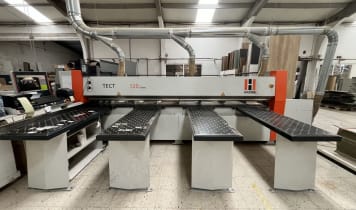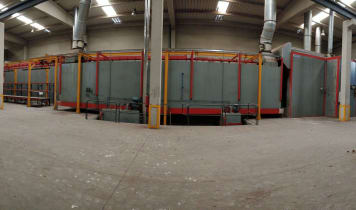The wide range of woodwork machinery starts with simple manually-operated tools and ends with large-scale industrial woodworking machines. In most cases, wood machinery works by machining the material or scraping off layers to attain the desired form using a wide selection of tools. However, there are woodwork machines that maintain the volume and mass of the material while transforming its shape. Wood can also be bent to any shape needed using pressured steam, which does not alter any of the positive aspects of wood.
The range of woodworking tools and machinery available are best explained by following the journey of the material from its beginnings as a tree trunk to the completed product.
Sawing
Timber harvesting
Tree trunks are today no longer divided using axes; this is the job now performed by saws. Chainsaws are the number one basic type of woodwork tool but they are often complemented by more modern harvesting machines to increase productivity and considerably increase safety. These include saws, especially in the eponymous 'sawmill’, which can take a variety of forms.
Cutting
Sawmills
Stationary wood sawing machines, such as chainsaw-type devices and circular saws, are used in sawmills to cut the tree trunks delivered into manageable sizes. The circular saws used are often of a considerable size.
Saws for construction sites and workshops
Sliding Table Saw ALTENDORF F45 (source: altendorf.de)
Significantly smaller but no less powerful are hand-operated circular saws, construction saws, mitre saws and sliding table saws, which are put to good use at construction sites and in workshops around the world. Circular saws also include panel saws, as found in the field of chipboard production.
The bandsaw is the ideal tool for dividing up wood into sections from materials of almost any width. Instead of a rotating disc, the bandsaw uses a circular saw belt held in place by tension which results in it being less durable than its circular saw cousins. However, as consumables, the saw belts are very affordable.
Removal of material
Reducing a solid piece of material to exactly the right length or breadth requires special wood tech tools, such as the widely used wood planer. Planing machines are an age-old tool from the field of woodworking. The classic type is a hand-held plane, which is still used in large numbers by carpenters. The device simultaneously provides the wood with a smooth surface.
Today, there are also electrically-powered planing machines to complement the traditional variant. These work using a rotating blade roller, even in their large-scale industrial equivalents. The thicknessing planer and surface planer are used to reduce large volumes of beams and boards into a consistent thickness.
Precision machining
Milling machines
The milling machine is also a key piece of kit for woodworking operations. Instead of a saw blade, mills operate using a rotating sawing head whose design determines the milling edge profile. Milling machines are used to manufacture wooden profiles and to machine individual contours into panels and solid materials. A wide selection of tools has also been engineered for woodworking mills. The smallest and simplest mills are known as routers, which are used as joinery machinery by many carpenters. Once equipped to a work table and fitted with a mechanical stop, routers transform into spindle moulders. This is the standard tool for manufacturing wooden profiles, such as skirting boards or window frames. The highest quality mills are CNC milling machines. These feature a milling head that can pass through a wooden block on all sides via three to five axes to create every type of product imaginable.
CNC perfection
CNC mills are used to create serial-quality complex contours and primarily differ from metalworking machines in terms of their rigidity. Wood being a relatively soft material means that the machines do not need to withstand the enormous resistance and strain experienced by metalworking mills. In place of a cooling lubrication unit, CNC woodworking machines rely on powerful extraction. Extraction is particularly essential for wood processing since complex machines are very sensitive to accumulations of dust.
Another key difference is the relative lack of 3D processing compared to metalworking. However, CNC technology is very important within 2D woodworking, which is why the majority of CNC woodworking machinery is found in the panel-working sector. It is used to mill precise and consistent contours into specific panel materials across a range of scales.
Assembly
Drilling machines
Bore holes are often introduced to wooden products for pins, threaded pins, bolts and much more to be inserted.
The hand drill is one of the oldest types of woodworking equipment, which has since developed into a number of powerful electric drills and highly efficient drilling stations. Using these, any type of bore hole pattern can be drilled into a material with consistently precise results. Boring machines are sought-after for furniture manufacturing and are especially ideal for chipboard processing.
Doweling machines
The drilling machine range is also home to dowelling machines, which are used to place dowels and pins into pre-drilled holes. This makes flat-pack furniture possible where a number of different parts need to be put together by the customer to form the final product. Without drilling and dowelling machines, the furniture world as we know it would be very different.
Cylindrical turning
Wood-turning lathes
The wood-turning lathe is the cornerstone of every carpentry operation. Anything that needs to be made round can be processed on this predecessor of the regular lathe. The wooden material is clamped in place and rotated longitudinally. A chisel tool can then be used to create a contour around the entire circumference of the item. The simplest wood-turning lathes are expansion units for regular drilling machines. Today’s industrial wood-turning lathes are computer controlled and can be relied upon to deliver workpieces of consistent quality and dimensions.
Final polish
Grinding and polishing machines are responsible for performing the final processes of woodworking. They scrape off the smallest imperfections and create a soft and smooth basis for ongoing machining. The machines used are belt- and plate grinders, which can take the form of electrical hand-held tools through to industrial machinery for large-scale serial production.
Veneer processing of chipboard and profiles
Veneering technology
Veneers are a key material for making chipboard look more attractive and natural. The need to process veneers has resulted in a range of very complex and versatile machines. One of which is the veneer peeling machine, which operates according to principles similar to those of the planing machine, but with these devices, it is the tree trunk that is turned; not the blade. Peeling machines are highly-efficient industrial machines which can process a trunk into paper-thin veneer in a matter of seconds.
Presses
Veneer presses are the simplest machines used to place a veneer layer on chipboard but their efficiency is outstanding. Basic veneer presses are often substituted by multi-daylight presses due to the demands of serial production. They can be used to turn huge numbers of chipboard panels into beautifully veneered products in a single work cycle.
Edge banding
The task of layering veneers onto chipboard profiles and edges can be particularly demanding because they are not levelled or arranged in convenient right angles. Other types of edgings, such as convex, concave or layered, also require the right machine to apply veneers, which is why edge banding machines and machinery for soft- and post-forming were developed – some of the most complex machines in the woodworking industry.
Surfacing and finishing
The tasks of surfacing and finishing wooden materials are also served by a range of machines. Veneer presses, as mentioned, are just one small part of the process where wood is given a special top layer or coating. Wood is sufficiently versatile to also enable conventional painting machines to be used. Industrial painting stations are widely used in large-scale production and make it possible for every type of wooden product to be rendered in any colour or surface quality.
Peripheral wood machines
Professional wood processing requires a range of peripheral devices, such as for delivering materials, transporting goods, and removing the waste products created.
Extraction and shredding
For example, each woodworking machine needs a powerful extraction unit to prevent the chippings and dust created from overwhelming the workshop. Extraction equipment is used to gather the chips and dust and forward it for ongoing processing, such as compression into chipboard or pellets for wood-burning stoves.
Waste wood is created in many types of woodworking tasks, even when the machines are modern, efficient, and designed to keep unnecessary cuts and by-products to a minimum. Wood-hacking machines then come into play to break down offcuts and make the waste materials suitable for further downstream woodwork equipment.
Handling & Transport
Industry has also developed a range of machines for transporting wooden products, the main one being chipboard, such as turnover stations, stacking and palletising equipment, roller tracks and conveyor belts.
There are also many further peripheral machines available to the woodworking field: specialist packing machines, wood-handling solutions, and many more. The world of woodworking machines is massive.



















































